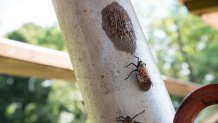The pesky flying insect spotted lanternfly is set to return this year, but New York State predicts that the emergence could happen sooner rather than later, which could catch at-risk agricultural businesses off guard.
The reason could be due to the stretch of summer-like weather during the early weeks of spring and as temperatures continue to climb -- something that could jumpstart the spotted lanternfly timeline, according to the New York State Department of Agriculture and Markets.
"In fact, with the warmer weather New York State is facing, we expect that SLF [spotted lanternfly] may hatch earlier this year, within the next month or even sooner, in NYC, Long Island, and the Hudson Valley," Director of Plant Industry Chris Logue said.
Brian Eshenaur studies invasive species at Cornell College of Agriculture and Life Sciences and New York State Integrated Pest Management (NYSIPM). He says that hatching could be bumped up to early May.
Get Tri-state area news and weather forecasts to your inbox. Sign up for NBC New York newsletters.
"With that jumpstart, it also means they could become adult spotted lanternflies (the stage we all recognize) sooner. So, they may occur earlier than we would normally see them which is about the third week in July," said Eshenaur to News 4.
The spotted lanternfly is an invasive species native to Asia. According to Princeton High School teacher Mark Eastburn, these bugs made their first appearance in Pennsylvania years ago.

"I live in Pennsylvania, and the spotted lanternflies first showed up in 2014. There was a shipment, from what I understand, of paving stones that came from China," Eastburn told NBC New York.
These insects like to lay their eggs on flat, hard surfaces. The egg cluster that was attached to the stone shipment arrived in Redding, Pennsylvania, and from there, the lanternflies have been spreading ever since across northeast regions in New Jersey, New York and Connecticut.
Having no true indigenous predators in the U.S., the hitchhiking bug gravitates toward farms and vineyards as a food source. This planthopper is known to feed off of more than 70 plant species, like fruit trees, grains and vines, with the tree-of-heaven being the bug's fan favorite.
To give further perspective, New York is estimated to produce more than 30 million bushels of apples each year, while grapes are valued at an annual harvest of $52.8 million, based off New York's Dept. of Agriculture and Markets.
With the potential of an earlier appearance by spotted lanternflies, experts are advising residents to inspect hotspots, like tree trunks and playgrounds, and scrape off egg masses.
"So we ask that residents look for spotted lanternfly egg masses and scrape them with a credit card or something with a hard edge. They have to press somewhat hard on the egg mass and will need to hear the eggs popping as they press on them to know they are being effective," said Jeff Wolfe, Public Information Officer at the New Jersey Department of Agriculture, to NBC.
Spotted lanternfly are no direct threat to humans as they do not bite or sting people, but vineyard managers and growers should be prepared in both Hudson Valley and Long Island.




